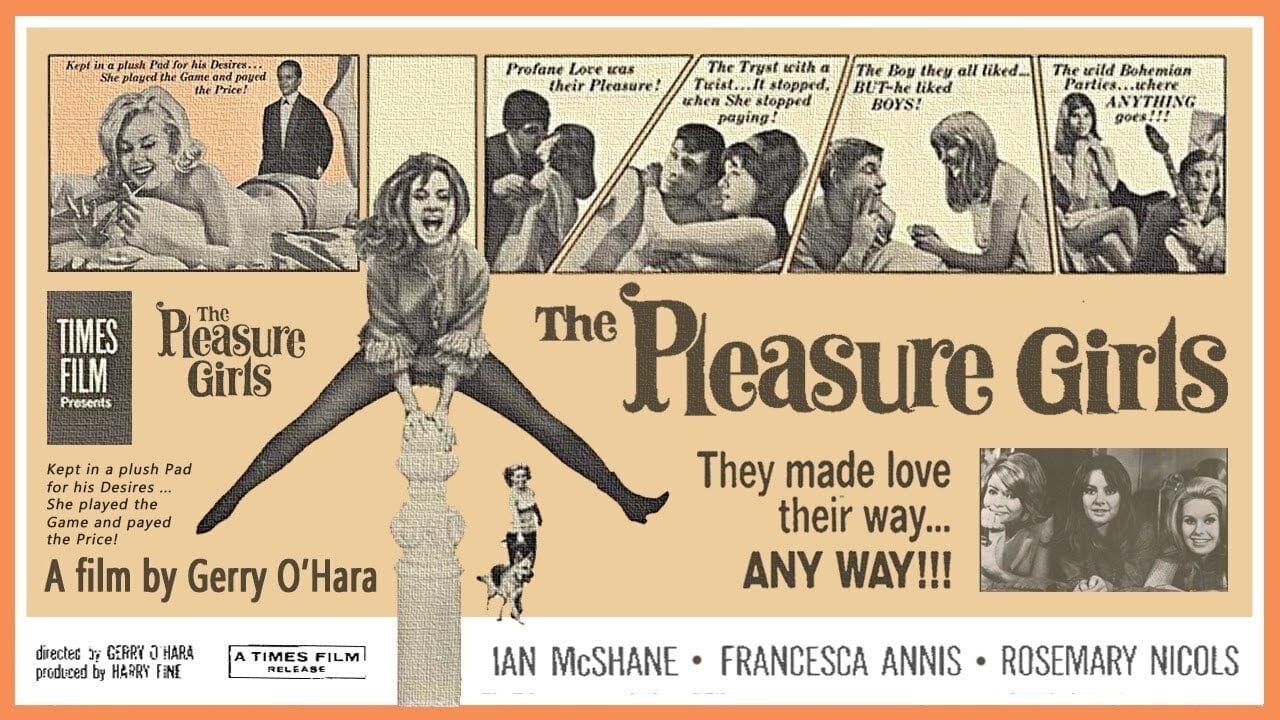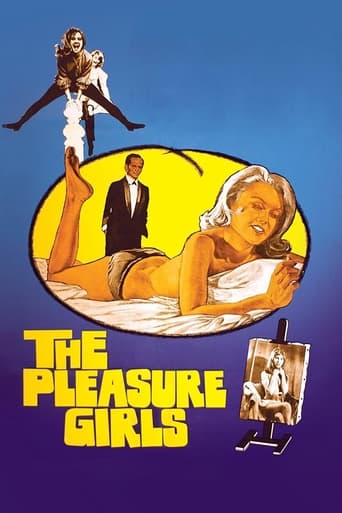

I really wanted to like this movie. I feel terribly cynical trashing it, and that's why I'm giving it a middling 5. Actually, I'm giving it a 5 because there were some superb performances.
... View MoreTrue to its essence, the characters remain on the same line and manage to entertain the viewer, each highlighting their own distinctive qualities or touches.
... View MoreA terrific literary drama and character piece that shows how the process of creating art can be seen differently by those doing it and those looking at it from the outside.
... View MoreA clunky actioner with a handful of cool moments.
... View MoreDistinct from the British New Wave is the 'swinging London film cycle' which really kicked off in 1965 and contains some fine films.This is a weekend in the lives of a bunch of big-haired Kensington girls, yah, when it was apparently possible to live in Kensington and be penniless. It could easily be the story of the young Patsy from Absolutely Fabulous.Francesca Annis is the new arrival, quickly getting hit on by Ian McShane. The scenarios are predictable enough: all night parties, stumbling home at dawn, discovering someone is gay, feckless boyfriends, even one of those "there's something I have to tell you, Vic" scenes.It's basically domestic - with tea-making detail and shouting to the milkman out of the window - but vibrant enough, and with a lot of smart repartee. To add a bit of maturity there's a quaint sub-gangland subplot with Klaus Kinski (sounding like Peter Lorre) as their hard-but-not-all-bad landlord getting his comeuppance.It's melancholy in places but never dour and it works well as the story of a mildly wild weekend in swinging London - and the sight of Ian McShane's dancing technique may never leave you.
... View MoreGerry O-Hara's follow-up to the similarly teasing (and unjustified) title That Kind OF Girl. The story then was of an Austrian au pair arriving in London, this time it's Sally (Fransesca Annis) from East Grinstead, a would-be model moving into a Kensington flat-share with three other girls. The action, if that's the right term, centres around the girls and their boyfriends amongst whom are Klaus Kinski playing a shady landlord, and Ian McShane as Keith, a photographer who takes a shine to Sally. This is unfortunate as all the characters are totally vacuous and any dramatic tension is limited to Keith's pitiful attempts to persuade Sally to go 'all the way'. There's a bit of gambling, an unwanted pregnancy and the inevitable parties - social realism minus the kitchen sink.At least there's none of the confused moralising that marred O'Hara's earlier work, though one of the DVD extras does contain a tell-tale sign of the times. I checked the clips marked 'Scenes For Export Only' and the only difference I was able to discern from the UK release was the addition of a pair of breasts and a profile of a nipple which, of course, only foreigners possessed in 1965.
... View MoreSet in 1960's 'Swinging' London, The Pleasure Girls follows a group of free-spirited bohemian-type girls who share a flat. Sally (Francesca Annis) is a new arrival, and soon hooks up with bad-boy Keith (Ian McShane) and the two begin to fall in love. One girl has to put with her gambling-addicted husband who pawns a brooch heirloom for a poker game and ends up losing the money amongst other things. And another girl dates the successful and rich flat landlord Nikko (Klaus Kinski) who gets himself into trouble with a gang of thugs. And that's pretty much it really.Released as part of BFI's 'Flipside' collection that has recently come to DVD and Blu-Ray, the collection is there to show an alternative side to British filmmaking. Alternative they most certainly are; good they are generally not. I watched The Pleasure Girls a couple of days ago and can barely remember a scene. The film certainly serves as an interesting time-capsule, and it's nice to see a more innocent and forward-thinking time where style dominated the youth and sexual liberation was in its early stages. It also has two promising young actors in McShane and the incomparable Kinski. But overall, the characters are annoying, the plot plodding and uninteresting, and a title that was a titillating disguise for a rather desperately dull film.www.the-wrath-of-blog.blogspot.com
... View MoreThis is a low budget black and white film which is a real archaeological curiosity from the social history point of view. It is a completely accurate portrayal of part of what was going on in London back then. The girls' clothes, makeup, and hair are absolutely perfect, for the simple reason that this film was made while it was all still happening, and that's what those girls looked like when they were at home, and not just on the film set. In order to try to make this little 'slice of life' film, with its slender story, appeal to the public, it was given a sensational title and tag line. But the film is really just about a group of silly girls aged about 20 who are sharing two floors of a house called Tudor Court in Lexham Gardens, W8, on the borderline of Kensington with Earls Court. In the film there is conspicuously little traffic on the roads, with no parking meters or restrictions, which is what life was like then, when everyone was as free as a bird to do what he or she liked, and the police state, surveillance, monitoring, and paranoid control by 'authority' had not yet come into being. The main character is a girl of about 20 played by a young doe-eyed Francesca Annis. She leaves home to go up to London and attend modelling school (which is what a lot of feather-headed girls of good family did in those days) and move into a flat with girlfriends and also the gay brother of one of them. The film is interesting as far as it goes, but the trouble is that none of the characters is interested in anything or does anything, except for one. That one is played by the young Klaus Kinski, and he is a youthful slum landlord who spends his spare time gambling in casinos, while his girlfriend shares a flat with Annis. Kinski gets savagely beaten up by competing thugs, but that is just a subplot. No one in the film gives a moment's thought to anything other than sex, gambling, and the mating game. Hence the 'pleasure girls'. The total vacuity of the characters in this film is most alarming. When people are that empty-headed it hardly matters which ones are the nice ones and which ones are the horrid ones, as none of them has any merit anyway. A great deal is made in the film of one young man who is a compulsive gambler who forces one of the girls in the shared flat to give him her only valuable possession, an heirloom piece of jewellery. He then takes it and sells it and gambles away all the money that same evening. But if the girl is that stupid, why is she any better than the man who is that unscrupulous and callous? The fact is that none of the characters is of any interest whatever. Ian McShane plays the boy Annis falls for. But in terms of the story and the people, who cares. The only interest this film has now, which it did not have originally, is its accuracy in recording precisely what those kind of girls were like then in those kind of flats doing those kind of silly things. And how I hated the beehive and bouffant hairdos then! But at the time the weird eye makeup of the period appeared perfectly normal and did not look strange, because all the girls were wearing it and there was no one to compare them with. How uncritically one accepts most of the styles and fashions of every period in which one lives! Apart from those hairdos, the other thing I hated most came in some time later, and that was men's bell bottom trousers. To think what one has to endure just because 'everybody is doing it'! Even if you refuse to wear them yourself you have to watch all the other people wearing them, and that can be torture, when they are ugly and offensive to the eye. I objected to every pair of bell bottom trousers I ever saw, but my hatred of them never made them go away, so it was wasted. And as for those terrible hairdos, the girls were utterly impervious to fact that they were hideous. All that preening in front of mirrors looking lovingly at their own hairdos which were the apotheosis of ugliness! How uncritical is the human eye! This film was a bizarre trip down a small corner of memory lane which, although interesting, was a sad and sobering experience. Were so many of the girls one knew in the 1960s really that boring and stupid? The answer is, alas, probably yes.
... View More